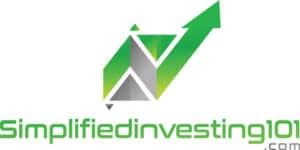
Step #1: Open a Brokerage Account
A brokerage account is an investing account that allows a person to buy and sell stocks. In the past, people have to call their brokers to buy a stock and pay expensive fees.
In a savings account, one can only hold cash inside it. In a brokerage account, people can buy and sell stocks or other assets like ETFs and mutual funds inside it. Also, it is up to you how long to hold a stock before selling.
Today, we can buy and sell stocks whenever we want as long as we have access to the Internet.
In United States, they have brokerages like Robinhood, Webull, and TD Ameritrade that allows users to trade stocks for free or less than $1 per trade.
Investing platforms that are available in Canada are Questrade, Wealthsimple Trade, and the big banks like RBC Direct Investing. Here is a quick comparison.
| Wealthsimple | Questrade | Big Banks | |
| Fees per USD buy or sell | 1.5% | $4.95 USD | $9.95 USD |
| Fees per CAD buy or sell | $0 | $4.95 CAD | $9.95 CAD |
| Real Time Quotes | 15 Min delayed | Yes | Yes |
| Minimum Req. Balance | $0 | $1,000 | Depends |
| Research Center | Not Available | Yes | Yes |
Taxes
Taxes on Investing income depends on what account you are using in buying stocks. The most common kinds of account in Canada are TFSA, RRSP, and Non-Registered.
For the most part, taxes on a non-registered account like Personal account or Cash and Margin accounts is usually half of the tax rates from employment income, or can be the same tax rate as employment income if earned from day trading or active trading.
Gains are taxable on the year a stock is sold. On the other hand, gains inside a TFSA account are tax free while RRSP account is taxed during withdrawal and a tax deduction at time of contribution.
Gains in RRSP account are not taxable when it is sold. It will only be taxable when an individual withdrawals from it, regardless if it resulted from profit or loss.
For full comparison on these 3 accounts, check out this article.
RRSP
- Contributions (deposits to RRSP account) are tax deductible initially
- Taxes are charged when withdrawing. The idea is, tax brackets are lower on retirement
- Buying stocks, ETFs, and other investments inside an RRSP is allowed
- Designed for retirement
TFSA
- Income from Investments like stocks inside a TFSA account is tax-free
- Limited contributions. Limited up to $6,000 per year. If you’re investing more than $6,000, you may have to consider a non-registered account.
- TFSA has the least requirement account to start investing. It may be recommended for beginners to start a TFSA account.
- Withdraw anytime.
Non-Registered (Personal or Margin)
- Day trading is allowed. Taxable.
- Can be used for long term investing or day trading. Taxes may be higher on day trading.
- Taxes are 50% of your normal tax rate. For example, Person A has a 40% tax rate. Thus, taxes on income from stocks in non-registered account is 20% (0.5 X 40%).
- Called “Margin” on Questrade, “Personal” on Wealthsimple, “Cash” or “Margin” on RBC Direct Investing. They are pretty much the same.
- No limit on investment.
You can open an RRSP, TFSA, or non-registered account with Questrade, Wealthsimple, or big banks like RBC Direct Investing.
Personally, I have a TFSA account with both Wealthsimple and Questrade.
When opening multiple TFSA or RRSP accounts, keep in mind that total deposits (contributions) to it are below the contribution limits. Otherwise, you may be subject to higher taxes.
On a Personal or a Margin account, there is no limit on withdrawals and deposits.
Video tutorial on how to buy and sell stocks with Wealthsimple and Questrade is on Step #4.
Step #2: Determine Your Initial Capital
To start investing, make sure to have money to invest in the first place. Also, it will determine what brokerage or type of account is suitable for you.
For example, if you only have $200 to invest, Wealthsimple Trade may be the best option since Questrade requires a minimum of $1,000. Thus, a Wealthsimple TFSA may be the best option.
In general, it may be best to start small so that potential losses are minimized. For example, losing 50% on a $10,000 account is a $5,000 loss while the same 50% loss in a $1,000 account is a $500 loss.
The most amount anyone can lose in stocks is the amount invested in a cash accounts and registered accounts like TFSA and RRSP. On a margin account, you may lose more than your capital. For this reason, a margin account may not be optimal for beginners.
Another example is if a person has $20,000 to invest, opening a TFSA account may not be an option since TFSA has a contribution limit of $6,000 per year (depends on age).
It may be advisable to start with little money when investing in stocks for beginners. After all, you can simply add or withdraw capital at any time.
Step #3: Build a Stocks Watchlist
A Stocks Watchlist is a set of stocks that you’re looking into. The best thing to get started is to think of 5 stocks to start looking into.
Then along the way, you can start adding stocks into your watchlist during free time.
You can build a stocks watchlist inside a brokerage like Wealthsimple or Questrade. But personally, I like the “stocks” app on my iPhone since it’s very basic and have the current news about a stock.
Building a Stocks Watchlist
Think of any big company or products that you like. Then search if they have a stock you can invest into. Stocks are simply a tiny piece of a company.
Simply type in google the name of the company plus the word “stock”.
For example, since I like Mcdonald’s, google “Mcdonald’s stock”. Or, you can google “Apple stock”, “Walmart stock”, etc.
Google will give you the basic info about those stocks. If a business expands and made a lot of money, their stock is likely to go up.
But if a business is getting small and loses a lot of money, their stock is very likely to go down.
Take note that only big companies are available to invest into the stock market. A small mom or pop shop that has 1 employee do not have stocks to invest into.
If you’re having trouble finding a stock to invest in, here are 7 Quick Ways to Find Stocks to Invest In.
Step #4: Buy your First Stock or Index Fund
Buying the perfect stock as the first stock is very unlikely. The great thing to do is to get started.
Try to be familiar with your investing platform whether it is Questrade, Wealthsimple, or big banks like RBC Direct Investing.
The key is to get started. Personally, I’d like to buy any stock and sell it immediately when I was getting started to be familiar with the platform.
After a couple of weeks or a month and you’ll be familiar buying and selling stocks with your Investing platform. The great thing is you can actually open several Investing Platform at the same time.
Here are 2 tutorials on how to buy and sell stocks. I use both Questrade TFSA and Wealthsimple TFSA. Wealthsimple for smaller investments and Questrade for investments above $300 in a single stock.
How to Buy or Sell Stocks using Wealthsimple
Wealthsimple Promotion (Optional)
If you are interested, you can get $10 sign up bonus when opening a new TFSA or Personal account with Wealthsimple by using the link below.
(Promo automatically applied in the link)
https://wealthsimple.sjv.io/PJQDN
Wealthsimple is available only in phones. $10 added after buying at least $100 worth of stocks if the link above is used before opening.
Wealthsimple Full Tutorial (minus buying/selling stocks) – 15 mins
How to Buy and Sell Stocks using Questrade
Questrade Promotion (New Users Only)
Get $50 in Free Trades Rebate by opening a new Questrade TFSA or Margin account.
Promo code automatically applied by clicking “Learn More” in the banner below and start opening an account.
If you are opening a new Questrade account, make sure to visit back to this page before opening and click “Learn More” in the banner below so that the promo code is automatically applied.

How it Works
For example, let us say we are going to buy 4 stocks at $50 each using Wealthsimple Trade.
If the stock is traded in Canadian dollars…
4 X $50 = $200
We will be paying $200 for the stocks. Since there is no commission fee, that’s it. If we sell at $60, that’s a profit of $10 per stock or $40 in total.
If the stock is traded in US dollars…
Let us say 1 USD = 1.3 CAD in this example. For the actual real time exchange rates, google “USD to CAD”.
Wealthsimple charges 1.5% conversion fees, so exchange rate will be 1 USD = 1.315 CAD
4 X $50 X 1.315 = $263.90
Stocks vs Index Fund
A stock is a tiny piece of just 1 company. For example, Apple or Amazon stock. Apple stock is an ownership in Apple.
If Apple’s value, as a company, doubled from $1 trillion to $2 trillion, then Apple stock will also double resulting in 100% gain.
Index Fund is a group of stocks. For example, Index Fund SPY gives ownership to each of the S&P 500 companies.
If the S&P 500 go up by 20%, SPY will also go up 20%. But if S&P 500 go down by 20%, SPY will also go down by 20%.
Warren Buffet advises to buy a low cost index fund like SPY if a person do not want to do any research. After all, SPY copies the return of the S&P 500, which is the average of the 500 largest companies in United States.
Step #5: Learn More and Gain Experience
Every expert was once a beginner. It is impossible to learn all about investing in just 1 week or 1 month.
Experience is the best teacher. There are a lot of Youtube channels and books out there that teaches the basics of the stock market.
Warren Buffet started buying stocks when he was 12 years old. He learned stuffs one step at a time. Do not force yourself, it may be best to learn about investing during free time when you feel like it.
Making mistake is very common for beginners, not just investing, but beginners in anything. The key has always been to learn from your investing mistakes and make sure to never repeat it.
